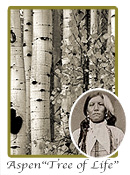| |
 |
 |
|

BROWNING MODEL 005
Living History Series
CRAZY HORSE KNIFE


Overall Length: 12"
Blade Length: 4 1/2"
Blade Material: Obsidian, Blued
Bolster: 4 Brass Point
Handle: Aspen Wood
Sheath: Brain Tanned Buckskin hand-made and beaded.
|
 |
|
|
|

Model 005 by Browning: "Tashunka Witko," Oglala Lakota Sioux Warrior. Crazy Horse was born around 1845 on the Republican River that traces the Nebraska-Kansas border. He was raised with tribal traditions of generosity, courage and self-denial. He ordered the attack on Lt. Col. George A. Custer's Seventh Cavalry and never surrendered the lands claimed by his people. When asked where were his lands, he replied, "My lands are where my dead lie buried." |
 |
 |
The Crazy Horse knife sports a handle made of wood from a grove of aspen trees, which grew on the sacred Pine Ridge Reservation land in southern Nebraska. The Aspen is revered by the Sioux Nation as the "Tree of Life." The 4 1/2" x 1 1/2" blade is made from knapped obsidian, a hard volcanic glass. Its color is variegated rust black and is affixed to the hilt with leather strips. Horsehair tassels dangle from brass cones, threaded with bone beads lashed to the leather binding. Four brass tacks represent the four seasons. The fringed buckskin sheath is brain-tanned, hand-made and beaded with a familiar Sioux pattern.
A certificate of authenticity is included. 1,847 knives — commemorating the year Crazy Horse was born — will be produced. |
|
 |
Overall Length: 12"
Blade Length: 4 1/2"
|
Blade: Obsidian
Bolster: 4 Brass Point |
Handle Source : Aspen- revered by the Sioux Nation as the "Tree of Life." |
 |
 |
 |
|
In answer to the white man's questions “Where are your lands now, Crazy Horse? Your people have gone back to the reservation. Where are your lands you fought for?” Crazy Horse sat on his pony and said nothing. He raised his arm up and pointed out and said “My lands are where my dead lie buried.” These words capture the spirit of Crazy Horse and were an inspiration for the design of the Crazy Horse Living History knife. The Crazy Horse Living History knife is bladed with knapped obsidian, a volcanic rock that forms when silica – sand – is intensely heated, a kind of unrefined glass that ancient cultures used for weaponry. The Lakota Sioux did not know metal until they met French fur trappers.
The core of “Knowing where you come from and where you are going” entwines with the concept of the tree of life. No other piece of history embodies this more than the sacred white aspen wood used in the Crazy Horse Knife. Known in Native American cultures as the Tree of Life, the white aspen grows freely in the mountains above 2,000 feet, ensuring their continuing abundance and freedom as it also ensures their continuance as People. Due to its white wood color, the white aspen are considered to be holy, and the trees also symbolize purity.
Russell Means, an Oglala Lakota, served as the first national director of the American Indian Movement (AIM) and became one of the organization's best-known spokespeople. Means was one of the Indian activists who, in 1969, occupied San Francisco's Alcatraz Island in a landmark AIM-led protest that lasted 19 months; in 1973, he helped lead the AIM takeover of Wounded Knee. Both events brought worldwide attention to the injustices and privation faced by American Indians past and present. As an actor, Means has appeared in such films as The Last of the Mohicans (1992) and Natural Born Killers (1994) and provided the voice of Powhatan in 1995's Pocahontas. Means graciously located and provided sacred aspen wood for the Crazy Horse knife as well as this story.
Tashunke witko , or Crazy Horse, was born around 1845 along the Rapid Creek near the Black Hills of South Dakota. During his boyhood, the Lakota Sioux had little contact with whites other than the occasional trader or soldier, and Crazy Horse was raised with tribal traditions of generosity, courage and self-denial. His father was neither a chief nor a tribal leader, but Crazy Horse won tribal leadership through his acts. His dreams became prophesy. Crazy Horse said he would never be hurt in battle, then demonstrated his belief in that vision by riding back and forth in front of enemies without being hit by a single bullet. At Little Big Horn, he rode to within 50 yards of enemy breastworks before calling his men to attack. His fearlessness made his men feel they were invincible, and they won a victorious battle against Custer's Seventh Calvary. But the White Man would not leave the West and Crazy Horse would never surrender the lands claimed by his people. When asked where his lands were located, he replied, “My lands are where my dead lie buried.” |
 |
|
|
|
|
| |
|
| |
|
|
|
|
|